 |
||||||||||||||||
| virtual Studio | References | Workshops | Styles of Frames | History | Collection | Gallery | ||||||||||||
|
|
||||||||||||||||||
|
The making of the frame for the Pfalz Gallery in Kaiserslautern |
||
|
|
||
|
|
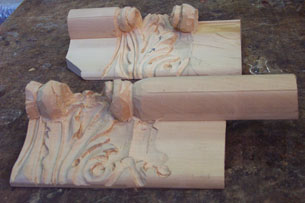 |
|
|
|
||
The carving process Attachment of the ornaments to the breadth and length of the frame, carving out the rough ornament structures, on the right is the finished, carved outer slat. |
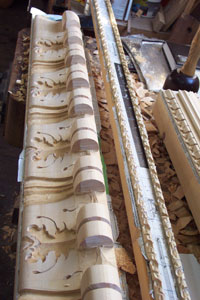 |
|
The finished, carved frame The blind frame consists of a scarf-jointed pine frame on which the linden wood frame with mitred joints is glued. |
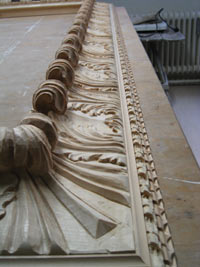 |
|
|
|
||
The glue size The glue size, consisting of a mixture of rabbit-skin glue and water, is painted onto the frame while hot, using a bristle brush. This causes the pores of the wood to open, which facilities a deeper penetration of the next layer. A further function of the size is to bind any dust or possible fatty residues from machines or tools. The black chalk The black chalk consists of ground Dolomite stone. The chalk base is made from a mixture of rabbit-skin glue, water and black chalk. It is applied in a warm state with a bristle brush. It forms the binding agent between the glue size and the chalk base and, when dry, is sanded down. |
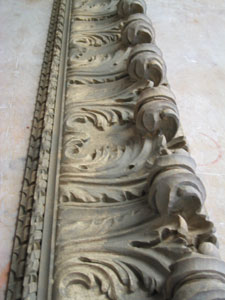 |
|
|
|
||
The gesso or whiting base Gesso consists of a mixture of specific amounts of rabbit-skin glue, water and whiting (Bolognese refined chalk). According to the requirements, up to ten layers may be necessary. In this case, we decided to apply “only” four layers so that the sharpness of the carved ornamentations was retained. The whiting is characterised in having a soft, smooth and elastic surface after wet buffing. This is necessary for bole gilding. |
 |
|
|
|
||
The yellow bole Bole consists of specially refined clay and is used by us in the colours yellow, red, white and black. The bole, bonded with rabbit-skin glue size, forms the immediate carrier surface for the gold leaf. It is applied warm with a hair brush directly onto the polished whiting. |
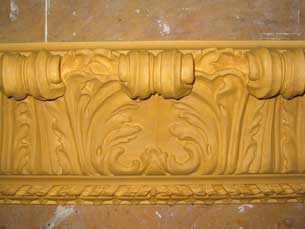 |
|
|
|
||
The red bole Red bole is applied to those areas that are supposed to shine in the finished state. The hue of the red is individually mixed each time in line with the master copy. The deepness of the lustre is controlled by the red undercoat. Matte gold, which is usually reserved for the backgrounds of the ornamentations, is unpolished and remains on the areas of yellow bole. |
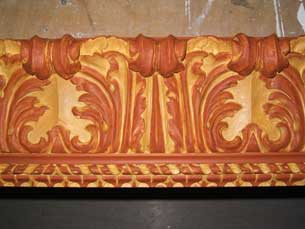 |
|
|
|
||
The gilding process After the bole application processes are completed, well dried and polished to a fine finish (any flaws or grit would ruin the appearance of the gilding), the gold leaf application can begin. A piece of the surface of the frame is mopped with gilder’s liquor (a mixture of alcohol and water) using a gilder’s mop, and then a leaf of gold is laid onto this wet surface using a gilder’s tip. This procedure is called “overlaying”. The liquor activates the small amounts of glue remaining in the bole, and, when dry, the gold adheres to the frame. When the gold leaf overlaying is finished and dried, the gold is burnished with an agate (a semi-precious stone). Actually, the gold is not really polished but this process condenses the basecoat, and due to this the gold gets its deep sheen. The matte gold areas are coated with the liquor, so that the gold leaf lies flat on the surface and the difference between bright and matte gilding appears more clearly. |
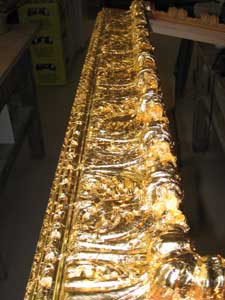 |
|
|
|
||
The toning process Once the frame is finished being gilded, it is toned and distressed (i.e. it receives a patina), so that it obtains a natural, aged look. |
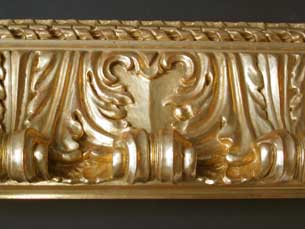 |
|
 Back to References Back to References Back to Workshops Back to Workshops |
||
